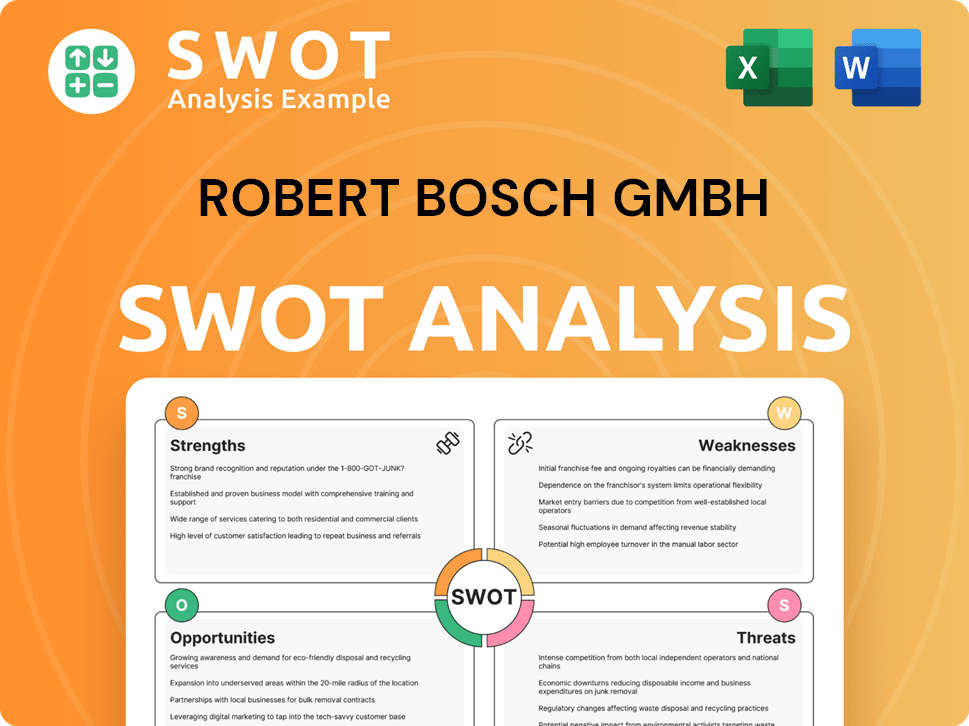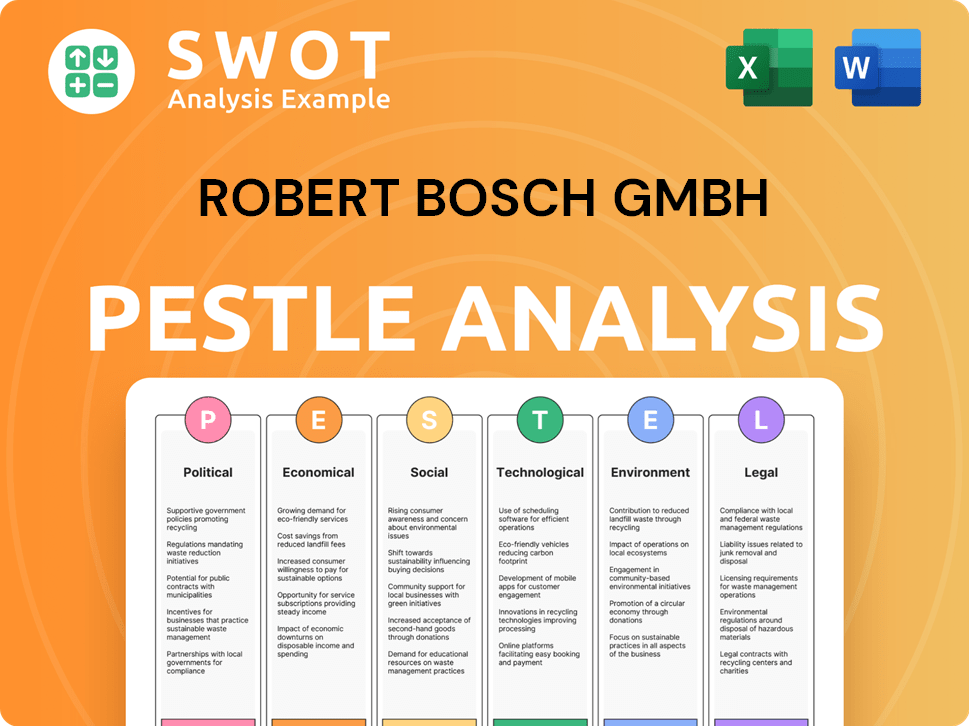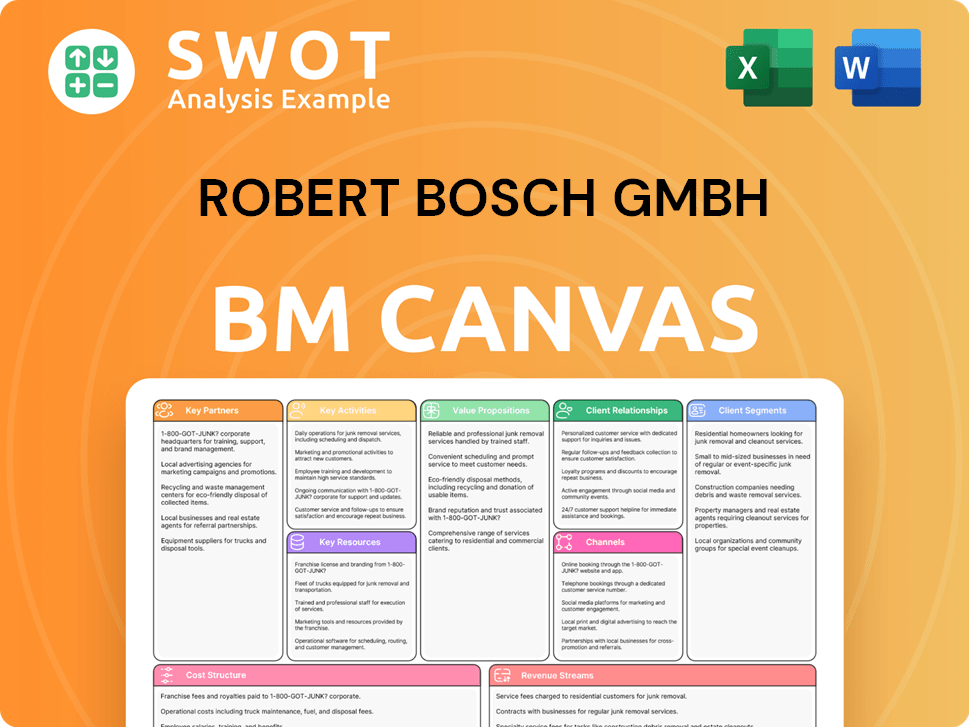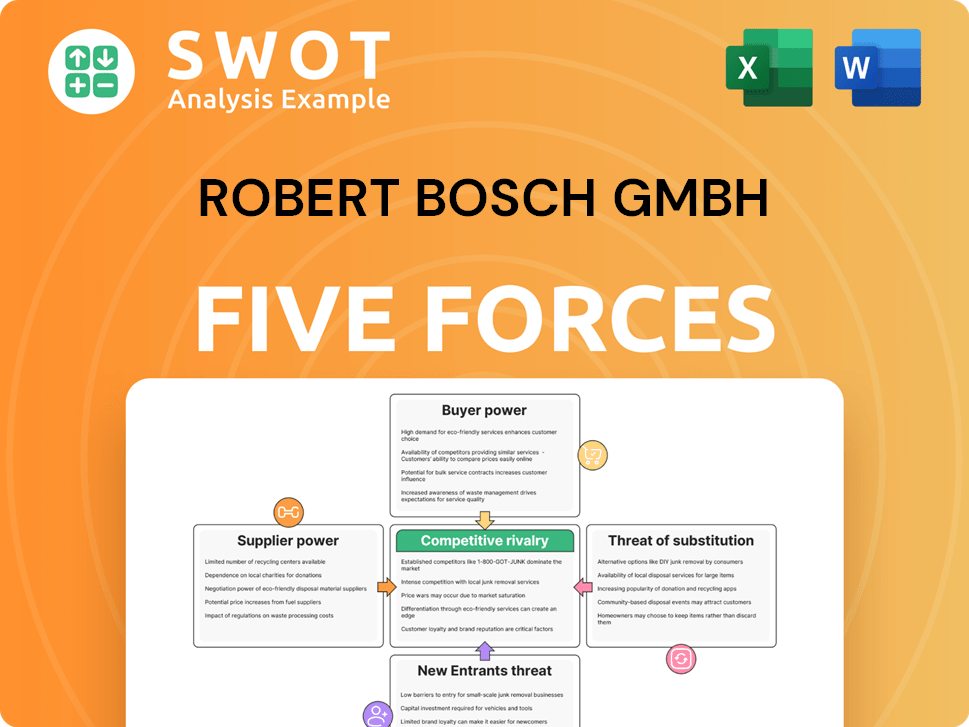Robert Bosch GmbH Bundle
Who Really Controls the Future of Robert Bosch GmbH?
Ever wondered what sets a global tech giant like Robert Bosch GmbH apart? Unlike many of its competitors, the Robert Bosch GmbH SWOT Analysis reveals a unique ownership structure that profoundly impacts its strategy and long-term vision. This structure, a cornerstone of its enduring success, dictates how the company prioritizes innovation and societal impact. Understanding the Bosch ownership is key to grasping its enduring influence.

Delving into the Bosch company's ownership reveals a fascinating story of how a privately-held entity navigates the complexities of the modern global market. The Bosch group's commitment to long-term investments, a hallmark of its operational strategy, is directly linked to its unique ownership model. Exploring the Bosch history and its evolution provides critical insights into its current strategic direction. Understanding who controls Robert Bosch GmbH is crucial for anyone seeking to understand its future trajectory.
Who Founded Robert Bosch GmbH?
Robert Bosch GmbH, a globally recognized engineering and technology company, was founded in 1886 by Robert Bosch in Stuttgart, Germany. Initially, the entire Bosch company was under the ownership of its founder, Robert Bosch. The company started as a sole proprietorship, a 'Workshop for Precision Mechanics and Electrical Engineering'.
Robert Bosch, an industrialist and engineer, established the company with a clear vision focused on precision engineering and innovation. His early efforts centered on developing and manufacturing electrical products, especially magnetos for internal combustion engines. These magnetos quickly became a crucial component of the burgeoning automotive industry.
As the company grew, Robert Bosch maintained strict control over its operations and ownership. There is no record of early external investors or family members acquiring significant stakes during the initial phase. The company's expansion was primarily funded by reinvested profits and, later, through internal financing. Robert Bosch's strong belief in social responsibility and long-term stability deeply influenced the company's eventual ownership structure.
Robert Bosch founded Robert Bosch GmbH in 1886. The company began as a sole proprietorship.
Initially, Robert Bosch was the sole owner.
The company focused on electrical products, particularly magnetos.
Growth was primarily funded through reinvested profits.
Robert Bosch prioritized social responsibility and long-term stability.
He aimed to keep the company independent and prevent it from being solely profit-driven.
Understanding the early ownership structure provides insight into the values that shaped the Bosch history and its evolution into a global entity. The initial focus on electrical components for the automotive industry set the stage for the company's future success. The fact that Robert Bosch retained full control in the early years is crucial to understanding the company's later unique ownership model, which prioritized independence and social responsibility over purely financial gains. Today, the Bosch group continues to operate in various sectors, employing approximately 427,600 associates worldwide as of December 31, 2023, and generating sales of €88.2 billion in 2023.
- Robert Bosch's vision emphasized precision engineering and innovation.
- The company's early growth was fueled by reinvested profits.
- The founder's philosophy prioritized social responsibility.
- The initial structure laid the groundwork for a unique ownership model.
Robert Bosch GmbH SWOT Analysis
- Complete SWOT Breakdown
- Fully Customizable
- Editable in Excel & Word
- Professional Formatting
- Investor-Ready Format

How Has Robert Bosch GmbH’s Ownership Changed Over Time?
The ownership structure of the Bosch company is a fascinating aspect of its history, particularly because it has remained a privately held entity. The most significant event in the evolution of Bosch ownership occurred after the death of Robert Bosch in 1942. His will dictated that the company's voting rights should be transferred to a charitable foundation to ensure the company's independence and uphold his philanthropic vision. This led to the establishment of the Robert Bosch Stiftung (Robert Bosch Foundation) in 1964, which fundamentally shaped the future of the Bosch group.
This unique structure separates economic benefits from voting control, ensuring that the company's strategic direction aligns with its long-term objectives and social commitments. This arrangement has allowed the company to invest heavily in future technologies. Understanding the ownership structure is key to grasping how the Bosch company operates and its commitment to long-term sustainability and innovation. This structure has remained largely unchanged as of 2024, ensuring stability and allowing the company to focus on long-term strategic goals.
| Aspect | Details | Percentage |
|---|---|---|
| Share Capital Held by Robert Bosch Stiftung GmbH | Economic Beneficiary | 92% |
| Voting Rights Held by Robert Bosch Industrietreuhand KG | Entrepreneurial Management Function | 93% |
| Voting Rights Held by Bosch Family | 7% | |
| Share Capital Held by Robert Bosch GmbH | 8% |
The Robert Bosch Stiftung holds the vast majority, 92%, of the share capital of Robert Bosch GmbH, acting as the primary economic beneficiary. However, it doesn't directly control the voting rights. Instead, the Robert Bosch Industrietreuhand KG holds 93% of the voting rights, ensuring management by individuals with industry knowledge. The Bosch family retains 7% of the voting rights. This structure allows the Bosch company to focus on long-term goals, such as investments in electromobility and artificial intelligence, as highlighted in the Revenue Streams & Business Model of Robert Bosch GmbH.
Bosch's ownership structure is unique and designed for long-term stability and philanthropic goals.
- The Robert Bosch Stiftung holds the majority of the shares.
- Robert Bosch Industrietreuhand KG controls the voting rights.
- The Bosch family also holds some voting rights.
- This structure supports long-term investments and strategic focus.
Robert Bosch GmbH PESTLE Analysis
- Covers All 6 PESTLE Categories
- No Research Needed – Save Hours of Work
- Built by Experts, Trusted by Consultants
- Instant Download, Ready to Use
- 100% Editable, Fully Customizable

Who Sits on Robert Bosch GmbH’s Board?
The governance of Robert Bosch GmbH, a key aspect of its unique structure, is overseen by a supervisory board. As of 2024, this board typically includes representatives from both shareholders and employees, reflecting the German corporate governance model. Key figures on the board include representatives from the Robert Bosch Industrietreuhand KG and independent members. Stefan Hartung serves as the Chairman of the Board of Management of Robert Bosch GmbH, highlighting the integration of leadership within the company's strategic and operational core. The board's composition ensures that decisions align with the company's long-term vision and values.
The supervisory board's role is crucial in guiding the strategic direction of the Bosch group. It ensures that the company's operations align with the founding principles established by Robert Bosch. The board's composition reflects a commitment to sustainable development and long-term value creation rather than focusing solely on short-term profits. This structure supports the company's ability to invest in research and development and maintain a focus on employee welfare and societal contributions. This structure is a key part of the Bosch company's commitment to its stakeholders.
| Board Member | Role | Affiliation |
|---|---|---|
| Stefan Hartung | Chairman of the Board of Management | Robert Bosch GmbH |
| Members | Representatives | Robert Bosch Industrietreuhand KG |
| Members | Independent Members | Industry Experts |
The voting structure of Robert Bosch GmbH is designed to ensure long-term stability. While the Robert Bosch Stiftung holds 92% of the share capital, the Robert Bosch Industrietreuhand KG controls 93% of the voting rights. This trust, composed of Bosch family members and current/former management, ensures strategic decisions are made with a focus on the company's long-term success. The Bosch family itself holds a minority of the voting rights, about 7%. This separation of capital and voting rights protects the company from external pressures, allowing it to prioritize research, development, and societal contributions. This unique structure is a key part of the Bosch ownership model, which is further detailed in the Competitors Landscape of Robert Bosch GmbH.
The governance structure of Robert Bosch GmbH is designed to ensure long-term stability and strategic focus.
- The supervisory board oversees management and strategic direction.
- The Robert Bosch Industrietreuhand KG holds the majority of voting rights.
- This structure protects the company from short-term pressures.
- It allows Bosch to prioritize research, development, and societal contributions.
Robert Bosch GmbH Business Model Canvas
- Complete 9-Block Business Model Canvas
- Effortlessly Communicate Your Business Strategy
- Investor-Ready BMC Format
- 100% Editable and Customizable
- Clear and Structured Layout

What Recent Changes Have Shaped Robert Bosch GmbH’s Ownership Landscape?
In the past three to five years, the ownership structure of Robert Bosch GmbH has remained remarkably stable. This stability reflects the deliberate design of its unique governance model, with no significant share buybacks or major shifts in the foundational ownership stakes. This contrasts with broader industry trends, where many corporations experience frequent changes in institutional ownership or increased activity from activist investors. The private, foundation-led ownership largely insulates the Bosch company from market-driven pressures.
Recent developments at Bosch have focused on strategic investments and internal restructuring to adapt to evolving technological landscapes. For example, in 2024, Bosch has been actively investing in semiconductor production and the development of software-defined vehicles. These areas require substantial long-term capital commitment, which its ownership structure facilitates. Public statements from Bosch executives and analysts consistently highlight the advantages of this ownership model in enabling significant investments in future-oriented technologies and maintaining a strong corporate culture.
| Key Aspect | Details | Recent Status |
|---|---|---|
| Ownership Structure | Primarily held by the Robert Bosch Stiftung and Robert Bosch Industrietreuhand KG. | Stable; no significant changes in recent years. |
| Strategic Investments | Focus on future technologies such as AI, hydrogen, and electromobility. | Ongoing investments in semiconductor production and software-defined vehicles. |
| Public Listing | Not a publicly traded company. | No plans for an IPO or privatization. |
The emphasis remains on sustainable growth and technological leadership, supported by its stable Bosch ownership that prioritizes a long-term vision over short-term financial gains. To learn more about the company's strategic direction, you can read about the Growth Strategy of Robert Bosch GmbH.
The ownership structure of Robert Bosch GmbH has remained consistent, primarily controlled by the Robert Bosch Stiftung and Robert Bosch Industrietreuhand KG. This stability is a key characteristic of the Bosch group.
Bosch is actively investing in future technologies, including artificial intelligence and electromobility. These investments highlight the company's commitment to innovation and long-term growth. The Bosch history is rich with innovation.
The Bosch ownership model prioritizes long-term vision over short-term financial gains, supporting sustainable growth. This approach enables significant investments in future-oriented technologies. This contrasts with the typical behavior of Bosch shareholders.
Robert Bosch GmbH is not a publicly traded company, which allows it to focus on long-term strategic goals. This structure provides the company with a unique advantage in the market.
Robert Bosch GmbH Porter's Five Forces Analysis
- Covers All 5 Competitive Forces in Detail
- Structured for Consultants, Students, and Founders
- 100% Editable in Microsoft Word & Excel
- Instant Digital Download – Use Immediately
- Compatible with Mac & PC – Fully Unlocked

Related Blogs
- What are Mission Vision & Core Values of Robert Bosch GmbH Company?
- What is Competitive Landscape of Robert Bosch GmbH Company?
- What is Growth Strategy and Future Prospects of Robert Bosch GmbH Company?
- How Does Robert Bosch GmbH Company Work?
- What is Sales and Marketing Strategy of Robert Bosch GmbH Company?
- What is Brief History of Robert Bosch GmbH Company?
- What is Customer Demographics and Target Market of Robert Bosch GmbH Company?
Disclaimer
All information, articles, and product details provided on this website are for general informational and educational purposes only. We do not claim any ownership over, nor do we intend to infringe upon, any trademarks, copyrights, logos, brand names, or other intellectual property mentioned or depicted on this site. Such intellectual property remains the property of its respective owners, and any references here are made solely for identification or informational purposes, without implying any affiliation, endorsement, or partnership.
We make no representations or warranties, express or implied, regarding the accuracy, completeness, or suitability of any content or products presented. Nothing on this website should be construed as legal, tax, investment, financial, medical, or other professional advice. In addition, no part of this site—including articles or product references—constitutes a solicitation, recommendation, endorsement, advertisement, or offer to buy or sell any securities, franchises, or other financial instruments, particularly in jurisdictions where such activity would be unlawful.
All content is of a general nature and may not address the specific circumstances of any individual or entity. It is not a substitute for professional advice or services. Any actions you take based on the information provided here are strictly at your own risk. You accept full responsibility for any decisions or outcomes arising from your use of this website and agree to release us from any liability in connection with your use of, or reliance upon, the content or products found herein.